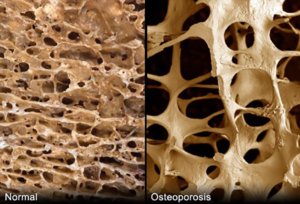
Osteoporosis is a polygenic disorder, determined by the effects of several genes, with each gene separately having only relatively modest effects on bone mass and other determinants of fracture risk. Recent advances in high-throughput “-omics” technologies have greatly increased the scale and scope of genomics research and recent studies have suggested that profiling of genetic variations could not only identify those at high risk of developing osteoporosis but also enhance the predictive accuracy of fracture prognosis.
In order to determine the effective onset of osteoporosis in an early stage in individuals predicted to be at risk, and to accurately monitor the evolution during treatment, the analysis of Bone Turnover Markers (BTMs) is emerging as a key route that could provide the required sensiti-vity/specificity. But although BTMs have shown clinically interesting associations with the rate of bone loss, the routine use of BTMs in clinical practice is complicated by large random within-patient variability (linked to diet, exercise, other medication etc.), and biologic variability (age, gender, body mass index [BMI], circadian, and menstrual variation).
The alternatives to BTM analysis such as DXA or ultrasonic measurements are expensive for smaller hospitals or private practices and/or lack sensitivity.
The early stage identification of high-risk individuals who would best benefit from intervention, and as a low cost in-office monitoring solution based on the measurement and accurate analysis of BTM values for patients with osteoporosis on treatment, are therefore two important gaps in the clinical armamentarium in osteoporosis management. However, with today’s technological advances, we believe it is possible to develop an in-office device capable of determining both the genetic predisposition and BTM values from a single drop of blood, at acceptable cost.
In order to develop such a device, various technologies including molecular medicine, nanobiotechnology, microfluidics, material sciences and biochemistry come together. While the proof of concept of different parts of the final device are already designed in the lab, their integration into a single device is still an idea and thus further tests are needed to confirm its accuracy for the final application.
The PoCOsteo project thus aims to integrate proteomics and genomics technology into a functional single PoC device and to validate the final instrument by comparing the results with that of the current state-of-the-art of each technology separately. The final device is aimed to be used by the physicians to identify individuals at high-risk of osteoporosis and osteoporotic fracture, to provide them with personalized care, and monitor the treatment process more efficiently.
This leads us to the overall objective of the PoCOsteo project : The aim of PoCOsteo is the development, clinical validation and preparation for commercialisation of a Point-of-Care tool for bone disease (a.o. osteoporosis) prevention, detection and treatment.
To realize this objective a balanced consortium of research partners and SME’s has been brought together, and a well-considered and logical work plan devised. The starting point are suitable unique electrochemical sensor technologies available at two research partners :
- Recently partner UGent has successfully developed and characterised an electrochemical proteomic sensor for 2 types of BTMs, i.e. proteins characteristic for bone formation and bone loss. The technology is protected by 2 patent applications.
- Partner URV is specialised in genomic electrochemical sensors and has an original technology for sensors, using cost effective Printed Circuit Board (PCB) based DNA electrodes.
These proteomic and genomic individual sensors will be further optimised in WP2 and WP3 respectively, and prepared for integration in a single disposable microfluidic cartridge. The integration of both sensors in the microfluidics will be tackled in WP4 by research partner IMM and SME partner microLIQUID (µLIQ), with mass-manufacturability of the cartridges as final goal.
The cartridges in turn are the key component of the complete PoCOsteo Point-of-Care tool, which will be developed by SME partner Labman in WP5, and which will include, next to the cartridges, also a fluid handling system, a read-out unit and the necessary software to drive the tool and extract the necessary bone health information from the measurements.
The completed PoCOsteo tool, including sufficient amounts of disposable cartridges will subsequently be delivered by SME partners microLIQUID and Labman to two hospitals, namely partners MUG (Graz, Austria) and EMRI (Teheran, Iran) who will clinically validate the tool and the bone health assessment method. This will be done in WP6.
Finally, it is the intention to valorize a successful outcome of these technical and medical activities through the preparation of a commercial start-up business plan, which will be done in WP7. It is indeed the intention of PoCOsteo to prepare the creation of a new company with participation of all contributing partners.
